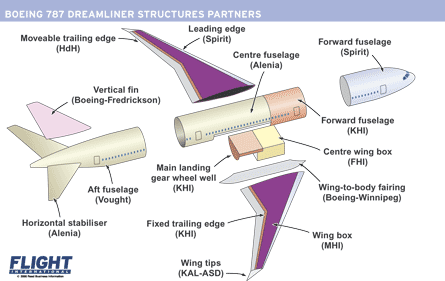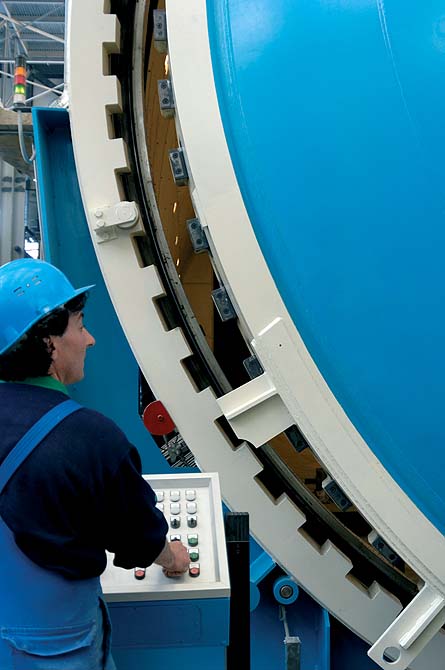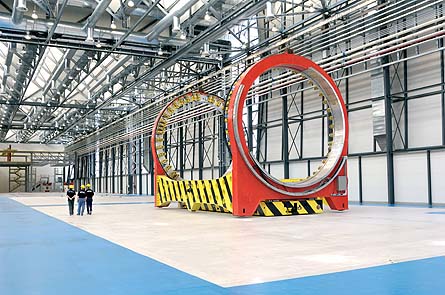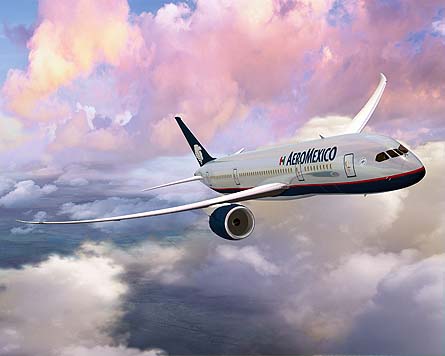By Guy Norris on Charleston, Grottaglie, Nagoya & Seattle
When Fuji Heavy Industry (FHI) engineers in Nagoya, Japan hurriedly peeled back the covers to reveal the first completed Boeing 787 wing centre-box skin to Scott Strode on 15 June, Boeing’s newly appointed vice-president of aircraft production appeared almost to bow in reverence to the moment.
|
|---|
| The autoclave at Alenia's Gottaglie is described as the largest in Europe |
“Seeing the first real piece of the structure is terrific,” said Strode as he closely inspected the large, black composite skin section with its co-bonded stringers. FHI had completed work on the first production composite lower wing centre-box skin section only three days before as part of the build-up to the start of final assembly of the centre wing-box scheduled for 27 June. The mating work, which will see FHI integrate its wing centre-box, or section 11, with the Kawasaki Heavy Industries (KHI)-made main landing gear wheel-well (section 45), officially marks the starting point for the manufacture of the first 787.
“Watching the team see the results of their design work materialise is more of a symbolic milestone, but it’s also a big part of this job,” said Strode, who is overseeing the build-up of one of the world’s largest industrial projects. “It’s not just the tip of an iceberg, it’s more than that. In terms of industrialisation we’ve got a massive team building up with things going on in countries as far afield as Japan, Korea, Mexico, Russia, Turkey and all across the USA. Sometimes it is staggering to think how many people are contributing at this time. We’re talking well in excess of 10,000 people.”
The first section 11/45 is to be completed in December and is expected to be shipped to the Global Aeronautica fuselage integration site in Charleston, South Carolina in January 2007 along with the first section 43 forward fuselage from KHI. Meanwhile, Mitsubishi Heavy Industries (MHI) is gearing up to produce the first shipset of 30m- (100ft)-long composite wing boxes, with delivery of the initial units planned for April 2007. In all, the three Japanese aerospace companies share 35% of the structural work on the 787.
“Our part is the first and has the highest loads,” says FHI 787 programme manager Yasuhiro Toi, who adds that the wing box is “similar overall” to conventional metallic alloy-based structures, but that “the detail is more sophisticated” to take advantage of composite materials with tailor-made thicknesses to provide strength where needed. Measuring 5.3 x 5.8m, the initial lower skin was followed within a week by the upper skin. Compared with the 3m-long main landing-gear door that FHI makes for the 777, “this is also the biggest [composite] piece for us”, he says.
Located close to the busy Nagoya harbour and industrial complex, FHI’s new West Handa plant houses composite fabrication for its 787 work, while assembly is performed in a newly erected 4,500m2 (48,000ft2) building in nearby Handa. “We decided to make a new plant here at Handa closer to the final shipping port,” says Toi, who adds that around 120 people are now working on the 787 programme at the two sites. FHI Boeing project general manager Hideyuku Sano says employment in the assembly area will climb to “between 150 and 160 during the production rate ramp-up”, although “we won’t need any more in the composite fabrication site even at the higher rate because of the higher automation of the facility, and it will actually drop to around 22 or 23”.
The composite fabrication site, covering a floor area of around 9,000m2, houses a high-speed automated lay-up machine, water jet trimming and drilling machine, non-destructive inspection (NDI) machines and sophisticated robotic automatic guided vehicles (AGV) that chime favourite Japanese karaoke tunes as they glide across the factory floor carrying immense sections from stage to stage. The AGVs transport parts to and from the autoclave which, at 7 x 7m in length and diameter, is one of the largest-diameter machines of its type in the world.
Although an automated lay-up device is being installed, the first six shipsets will be produced by manual lay-up. “We plan to finish work on putting in this machine around July, and will have it producing the first automated parts in the September timeframe,” says FHI Boeing project general manager Hideyuku Sano. “We also completed a [subscale] ‘half-box’ in early manufacturing trials at Utsunomiya [another FHI site], which we sent to Everett for EME [electro-magnetic effects] testing in September-October 2005.”
Site expansion
Toi says that during the build-up and testing of the skins “we have had a few problems, as usual, but no show-stoppers. The most difficult part is making it a stable product for large-scale manufacturing.” The completed wing-box has “a lower parts count and has fewer holes in it than a conventional article. It also does not need the extra strengthening usually required to fight fatigue,” he adds.
|
|---|
| Alenia's cavernous new site will produce around 60% of the 787's fuselage |
MHI is undergoing a similar site expansion, with several plants across Japan contributing to the 787 wing-box effort. The bulk of the work is undertaken at a newly expanded part of the Oye site, a section of which was formerly occupied by the Mitsubishi Motors group by the Nagoya dockside, and adjacent to the original design offices and assembly site that produced the A6M5 Reisen “Zeke” or “Zero” fighter during the Second World War. Here stringers longer than 22m will be fabricated and co-cured with skins made in the same facility that is also responsible for the final assembly of the complete wingbox. MHI’s Shimon Oseki site will make stringers less than 22m long, while the company’s Hiroshima plant contributed parts for the autoclave. Shinmaywa is subcontracted to produce composite spars.
The 47,000m2 composite fabrication factory was completed in mid-April, and incorporates an 8 x 40m autoclave to cure the 787’s long wing-box. Also including NDI, water jet and automated lay-up machines, the site was used to complete a successful fuel and seal test on a representative wing-box section in April. Earlier tests, running back over two years, have included tension/shear evaluations conducted in MHI’s Nagasaki site, and main landing-gear fitting strength tests at the company’s Kobe plant. The skins around the landing gear area are thickened to around 3.8cm (1.5in), compared with around 1.3cm for most of the remaining wing, to accommodate the higher loads.
The wharfside composite assembly factory is due to be completed by the end of August, or roughly one year before the 787’s scheduled first flight. Completed shipsets will be loaded directly on to barges at the dock and transported downriver to the nearby Centrair airport at Nagoya for shipment by 747 Large Cargo Freighter (LCF) to Everett. The site is sized to house up to 10 assembly bays as well as four pre-delivery bays and a split-level area housing a moving production line on the upper floor for systems installation. Each wing consists of main composite spars, skins and up to 18 composite stringers. The structure also includes 37 aluminium ribs, the largest of which are fitted to the wing centre-box.
A few kilometres away, KHI is busy preparing its new fuselage section 43 manufacturing sites for the 787. “We are working night and day preparing the factory with the first delivery near at hand,” says Hirokazu Komaki, KHI 787 programme manager. “The most remarkable thing is the development of the OPB [one-piece barrel] section. In terms of scale, manufacturing concept and scale, this has never been seen here before – it is a big event for KHI.” The OPB effort has also been challenging in terms of time, he adds, saying a formal agreement was not signed with Boeing until as recently as May 2005. “The development time has been shorter than previous programmes and KHI is now working hard to support this schedule,” says Komaki.
Gearing up
KHI also has responsibility for the main landing-gear wheel-well assembly (section 45), and the fixed trailing-edge, which is assembled from sections supplied by subcontractors throughout Asia. The first of these mostly metallic subassemblies will be completed over the next month, while the initial landing-gear structure is due for shipment to FHI by year-end. The large assembly site, which is scheduled to open formally in early July, was completed by 28 February and contains an 8 x 20m autoclave, a shear tie fastening machine and a panel fastening device for OPB assembly.
|
|---|
| KHI's autoclave will produce one-piece barrel fuselage sections |
Work on a similar Herculean scale is also underway in Alenia Aeronautica’s Grottaglie site near Taranto in southern Italy. Here the company is gearing up to produce the centre-aft fuselage section 46 and mid-section 44, which together make up around 60% of the fuselage. Eventually to be produced in four main lengths for the 787 family, section 46 will measure 10m to 15m-plus, with the exact size of the 787-10 variant yet to be determined. Section 44 measures 8.5m for the baseline variant, with the first set of fuselage sections due to be delivered by LCF to Charleston in January 2007.
Alenia is completing assembly of a massive main manufacturing building measuring 400 x 175m and around 24m high. Covering 70,000m2, the stylish building includes a 17 x 36m automated fibre placement machine, and an 8.5 x 19.5m autoclave described by the company as the largest in Europe. The cavernous site is scheduled to be completed early in the third quarter and is being prepared to begin work on a pre-production fuselage before starting assembly of the first production unit in the first quarter of 2007.
|
|---|
| Boeing's 747 Large Cargo Freighter has a key roll in collecting the finished sections for assembly in the USA |
Outside the site, which required 20,000t of structural steel and 50,000m3 (1.76 million ft3) of concrete, the main runway at Grottaglie is being almost doubled in length to 3,000m. Work on this project is due for completion in December 2006, with the first landing of the LCF expected in the middle of that month.

The LCF will deliver the fuselage sections as well as the Alenia-produced horizontal stabiliser to Charleston, although the tail unit will be merely staging through the Global Aeronautica site as cargo en route to Everett. The tail work represents a significant expansion of the supplier role, says 787 programme director Gugliemlmo Caruso. “We can say we are also the only partner responsible for the design and building, as well as the static and fatigue testing of a major part.”
Laminate parts
Building on skills developed for the 777 effort, which involves the routine assembly of the 14m composite flap section at Alenia’s Foggia plant, the company is producing a fully co-cured solid laminate monolithic part 1m long – the largest monolithic structure ever produced for a commercial aircraft, it adds. Initial pre-production units will be completed in the third quarter of this year, and assembly of the first production horizontal stabiliser will follow by the start of December 2006, with initial deliveries around January.
David Brigante, Alenia vice-president in charge of commercial aviation accounts, says the new relationship with Vought is vital, not only to the 787, but also to Alenia’s longer-term strategic ambitions. Before its tie-up with the US company, Alenia investigated opening its own US site. “We always had the idea of having an assembly area near the customer,” says Brigante, who adds it then considered buying a part of Vought from Northrop Grumman. The talks over this possible link resulted in Global Aeronautica. “That’s how it all started.”
Brigante believes the business has even more potential, particularly with the closer involvement of the Japanese “heavies”. “It could grow more,” says Brigante, who adds that the development of the 787 “created a small Airbus between us, Vought and the Japanese”. However, although the partnership is now working, “it was not easy”. Brigante says Alenia and Vought were close before the 787, but “with the Japanese it was not so immediate”. Alenia has been gradually building trust towards “becoming collaborative. In the end, it’s going to be better this way.” The partnership does not necessarily mean any tie-ups over future projects such as the Boeing 737RS. “On the next one, we are competitors,” he says.
Alenia thinks composites are the future. “That’s what we’re betting on, the composite fuselage,” Brigante says Alenia is involved in Boeing’s studies to increase the production rate beyond the already accelerated 10-a-month goal. “We are trying to understand how to react to this market.” If the decision is a further rate growth to a projected 14 to 16 a month target the Grottaglie plant “is not enough. It needs to grow. We have a lot of space to grow.” Although Alenia designed Grottaglie for higher rates, these were “not what we are looking at today”.
For Alenia, Brigante says the question is whether Boeing can sustain sales long enough for the company to recoup its investment to expand the factory. “Once you make the investment for a certain rate, how long is it going to last?” he asks. Alenia already plans to run three shifts at the factory, which will see employment rapidly rise from 320 people this year to 484 by 2008.
Across the Atlantic in Charleston, South Carolina, Alenia North America chief operating officer and Global Aeronautica board of managers chairman Vincenzo Caiazzo echoes the benefits of collaboration with Vought. “This combines the best of two companies to perform activities that in the past were not performed by either, and the investment here has allowed a foreign company to have access to a global industrial market. It is important for Alenia and Vought, and that’s why we decided to invest here.”
Supply chain change
Caiazzo says: “The new business model of the 787 has dramatically changed the relationship in the supply chain. Today, Boeing is changing itself into a large-scale integrator and the suppliers are expected to be vertically integrated partners capable of defining, producing and assembling complete systems and structures to deliver to the final integrator in Everett.”
The Global Aeronautica site by Charleston airport was selected in September 2004 and clearance of the dense wetland area began in March 2005 with the removal of vegetation and its associated banana spiders, snakes and alligators, says “Newt” Newton, the company’s vice-president and deputy general manager.
The site will integrate, align, drill and join together the bulk of the fuselage including the aft sections 47/48 from the adjacent Vought site at Charleston, the KHI-built section 43 and FHI-built section 11/45 fuselage parts from Japan, the Alenia-built sections 44/46 and the Boeing Winnipeg-built wing-to-body fairings from Canada.
All will be put together in the new 32,500m2 assembly and integration building, which involved the pouring of more than 34,300m3 (1.21 million ft3) of concrete and the use of 5,380t of steel. Including workers in Dallas, Seattle and Texas, the Global Aeronautica workforce will peak at 100 by year-end and reach around 400 “as we reach rate” says Newton. Initial pre-production units, using simulated “dummy” sections, will be test-fitted together in the fourth quarter of 2006, with the first of the real fuselages due early in the second quarter of 2007.
|
|---|
| Aeromexico is one of the latest airlines to have signed up for the finished product |
“The biggest concern is that we’re able to orchestrate the ‘dance’ of all the parts arriving for the first aircraft, and not letting them get out of sequence. Traditionally, it has taken us several aircraft to get it right, but we need to get it right pretty early,” says Newton, who adds that delays and hiccups are possible. “We’re all victims of human nature and sometimes you have got to expect delays.”
Equipment qualification
A few metres away, the new Vought site is also gearing up to begin assembling the all-composite, and reasonably complex, aft fuselage sections in its new 32,800m2 building. Some 6,500m2 of the site is dedicated to a composites manufacturing clean room, while the 9 x 23m autoclave is thought to be one of the world’s largest by volume. The site also includes Cincinnati Machine-supplied automatic fibre placement machines, PAR Systems trim and drill machines and Brotje-supplied automatic riveters. As with the other main 787 composite structure suppliers, Vought has selected an MTorres-built numerically controlled ultrasonic NDI machine to check for voids, porosity and delaminations.
Production of the first articles is due to begin this month, with the first set of fuselage sections due for completion in the first quarter of 2007. “We’re going through qualification for a lot of equipment, and getting into pre-production activities this month. We’re in the throes of that,” says Vought North Charleston site general manager Mark Dickey. “The first seven shipsets will be joined here [rather than the remaining units, which will be joined in the adjacent Global site] so we don’t have to duplicate training,” he adds.
Outside the two new factories a new taxiway is also being built to connect Charleston’s runway with the 787 fuselage assembly site. The taxiway, which will connect with the delivery bays behind the Global Aeronautica building, will allow the LCF to trundle right up to the building to collect its precious cargo.
Source: Flight International




























